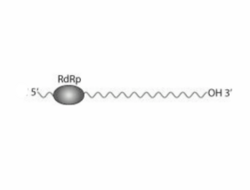Biology:Mitovirus
| Mitovirus | |
|---|---|

| |
| Mitoviruses have no capsid or viral envelope, RNA genome and RdRp form a naked ribonucleoprotein complex | |
| Virus classification | |
| (unranked): | Virus |
| Realm: | Riboviria |
| Kingdom: | Orthornavirae |
| Phylum: | Lenarviricota |
| Class: | Howeltoviricetes |
| Order: | Cryppavirales |
| Family: | Mitoviridae |
| Genus: | Mitovirus |
| Species | |
|
See text | |
Mitovirus is a genus of positive-strand RNA viruses, in the family Mitoviridae. Fungi serve as natural hosts. There are five species in the genus.[1][2]
Structure
Mitoviruses have no true virion. They do not have structural proteins or a capsid.[1]
Genome
Mitoviruses have nonsegmented, linear, positive-sense, single-stranded RNA genomes. The genome has one open reading frame which encodes the RNA-dependent RNA polymerase (RdRp). The genome is associated with the RdRp in the cytoplasm of the fungi host and forms a naked ribonucleoprotein complex.[3]
Life cycle
Viral replication is cytoplasmic. Replication follows the positive-strand RNA virus replication model. Positive-strand RNA virus transcription is the method of transcription. The virus exits the host cell by cell-to-cell movement. Fungi serve as the natural host. Transmission routes are parental and sexual.[1]
Taxonomy
There are five species in the genus:[2]
- Cryphonectria mitovirus 1
- Ophiostoma mitovirus 4
- Ophiostoma mitovirus 5
- Ophiostoma mitovirus 6
- Ophiostoma mitovirus 3a
References
- ↑ 1.0 1.1 1.2 "Viral Zone". ExPASy. http://viralzone.expasy.org/all_by_species/304.html.
- ↑ 2.0 2.1 "Virus Taxonomy: 2020 Release". International Committee on Taxonomy of Viruses (ICTV). March 2021. https://ictv.global/taxonomy.
- ↑ "Viral Zone". ExPASy. http://viralzone.expasy.org/all_by_species/303.html.
External links
Wikidata ☰ Q18819838 entry
 |

